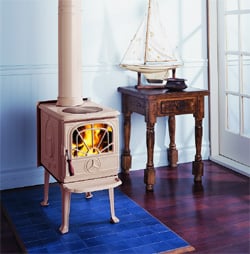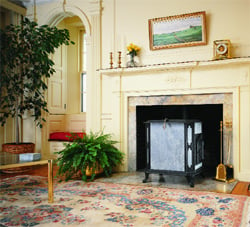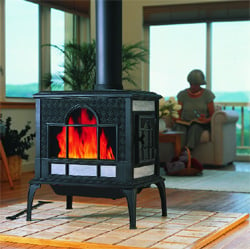WOOD STOVES
 Wood is good. There’s nothing like the smell, feel, and warmth of real burning wood. And tending a wood fire is an appealing challenge to many; it can even be an art.
Wood is good. There’s nothing like the smell, feel, and warmth of real burning wood. And tending a wood fire is an appealing challenge to many; it can even be an art.
Although burning wood can contribute to air pollution, there are good reasons to utilize wood as a fuel source. Wood itself is a renewable energy source. And unlike the carbon dioxide released in fossil-fuel burning, carbon dioxide released in burning wood does not contribute to global warming. Living trees take in the carbon dioxide that is released from burning wood, creating a recycling effect.
For areas prone to power outages, a wood stove may be a reliable standby for keeping homes heated in the winter months. If the power goes out, the flame won’t. In addition, by buying wood from local sellers, you are supporting your community rather than the giants of the utility industry.
Choosing Your Wood Stove to Match the Stlye of Your New House Plans
To choose the stove that’s right for your home, think about how much heat you want to produce and where you plan on installing the stove. Also think about the kind of stove you want. A wood stove is going to be a part of your home for a long time—do the research, find exactly what you want, and don’t be afraid to buy the best one you can afford. As far as safety and satisfaction are concerned, not skimping on cost will pay off in the long run. And don’t forget to look for the EPA certification sticker on the
stove that tells you the appliance’s BTU rating, or heat output.
 The large soapstone panels on this stove give it great ability to store heat. And because the firebox is totally lined with soapstone walls and a refractory bottom, this stove will hold coals much longer than other stoves. And the firebox is deep enough so that ash needs to be removed only at 7-10 day intervals. Photography: Courtesy of Woodstock Soapstone Co., Inc.
The large soapstone panels on this stove give it great ability to store heat. And because the firebox is totally lined with soapstone walls and a refractory bottom, this stove will hold coals much longer than other stoves. And the firebox is deep enough so that ash needs to be removed only at 7-10 day intervals. Photography: Courtesy of Woodstock Soapstone Co., Inc.
Wood stoves are available with and without a catalytic combustor. Similar to a car’s catalytic converter, the catalytic combustor helps the stove burn not only wood but also the gasses and other emissions that come from burning the wood, which makes it that much cleaner and more efficient. Noncatalytic stoves utilize a heavily insulated firebox, which helps to hold in heat and leads to more complete combustion. However, the key to the efficiency of the noncatalytic wood stove is a secondary combustion chamber that allows for even more gas and particle burning.
You’ll need to consider the size of the stove to ensure that it will fit where you want it to go. Also note the diameter of the flue, firebox volume, and the maximum length of wood that the box will hold. And note whether the appliance features top or rear venting as well as front or side loading, which has a bearing on where it can be installed.
Just because you don’t have much space for a wood-burning stove doesn’t mean you can’t have one. Stoves like these handsome cast-iron 1400 Series models are designed with limited space in mind. A small depth allows them to be installed in places where a protruding stove could cause problems and specially designed heat shields allow minimal clearances. Photography: Courtesy of Hearthlink International.
Options vary from model to maker. One option is an air wash system that allows air to constantly flow across the inside of the glass door to keep it clean. Other manufacturers offer a blower to distribute the heat. And others offer an outside air kit that draws in air from the outdoors into the combustion chamber (which means that if your house is very tightly constructed, you’re not burning up all the breathable air). Look for a brick-lined firebox that will help wood burn better and guard against additional fire hazards such as escaping embers.
The Palladian window of this stove is set gracefully into a gently cast pattern of diamonds, with soapstone panels below. The stove will comfortably heat several rooms, keeping the rooms warm for eight hours or more on a single load of wood. A large internal catalytic combustor increases efficiency and heat output, and reduces pollution. Photography Courtesy of Woodstock Soapstone Co., Inc.
Stove styles and materials have come a long way since the black pot-belied stoves of the past. Steel, cast iron, and soapstone stoves are common. Soapstone stoves are known for their ability to retain heat and maintain high burning. They are said to be best for overnight burning. Steel and cast iron are said to be best for cooking.
Created with traditional styling and ceramic coating, this cast-iron stove comes in a variety of colors, can be loaded from the front or side, burns for up to eight hours, and holds logs as long as 22 inches. Photography: Courtesy of Waterford.
 Ultimately, the material is secondary to style in most people’s minds. Wood stoves are often beautiful—the problem is that there are many beautiful designs to choose from. You can go with the traditional black, porcelain enamel-coated stove, or you can choose from a host of other colors. Some offer very basic designs, while others are more intricate, adorned with stone, tile, or marble accents. There is also a variety of leg and door design options, although most doors are made of ceramic glass.
Ultimately, the material is secondary to style in most people’s minds. Wood stoves are often beautiful—the problem is that there are many beautiful designs to choose from. You can go with the traditional black, porcelain enamel-coated stove, or you can choose from a host of other colors. Some offer very basic designs, while others are more intricate, adorned with stone, tile, or marble accents. There is also a variety of leg and door design options, although most doors are made of ceramic glass.
While this classic stove has traditional good looks with its blend of Danish, European, and American style, it is far from traditional. Its vintage style belies its modern, non-catalytic clean-burning efficiency. The firebox has the capacity to hold enough wood to burn through the night. Its rear exit height and overall depth make it ideal for installing in a fireplace or in a place where there is not enough room for it to jet out too much. Photography: Courtesy of Hearthlink International.

